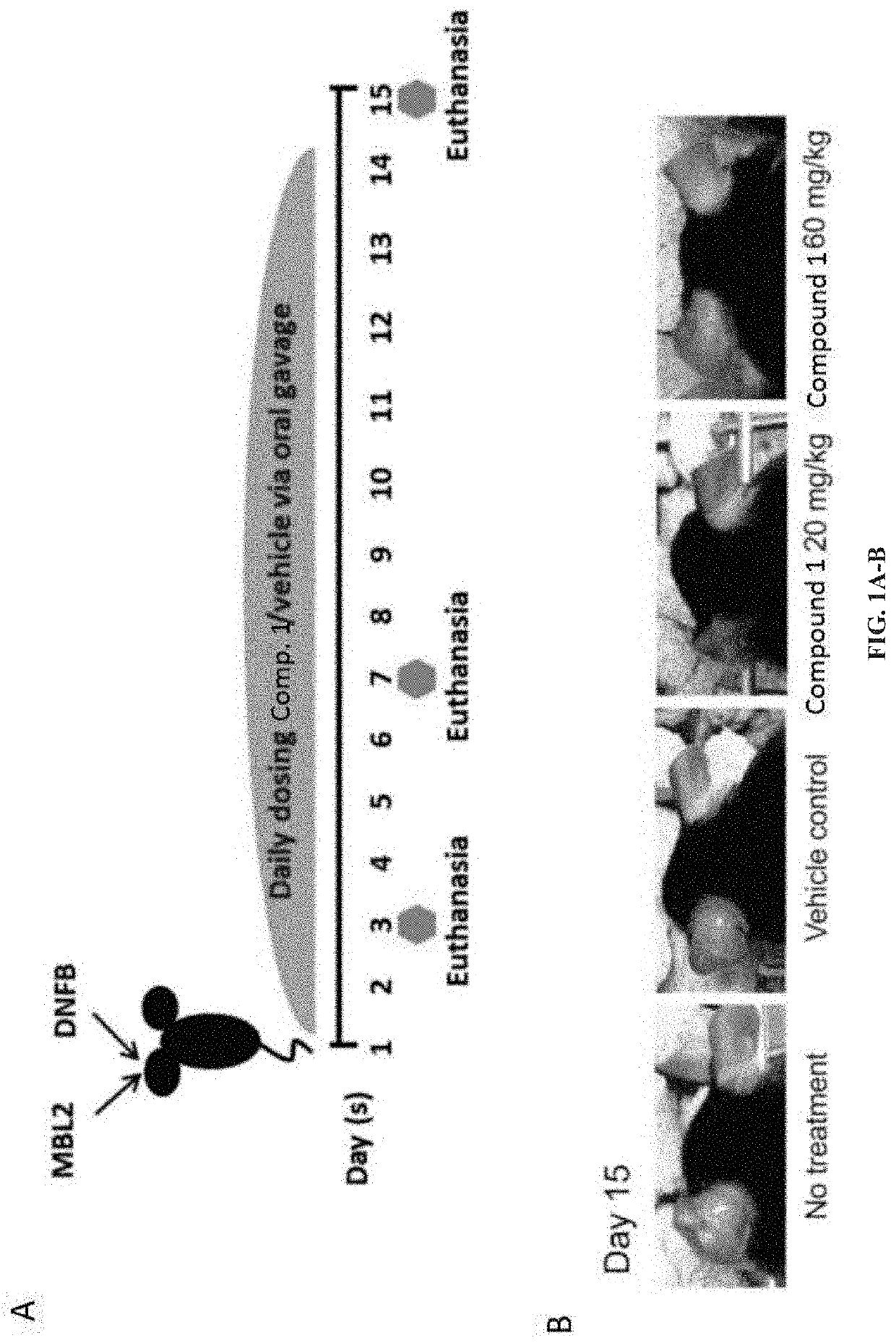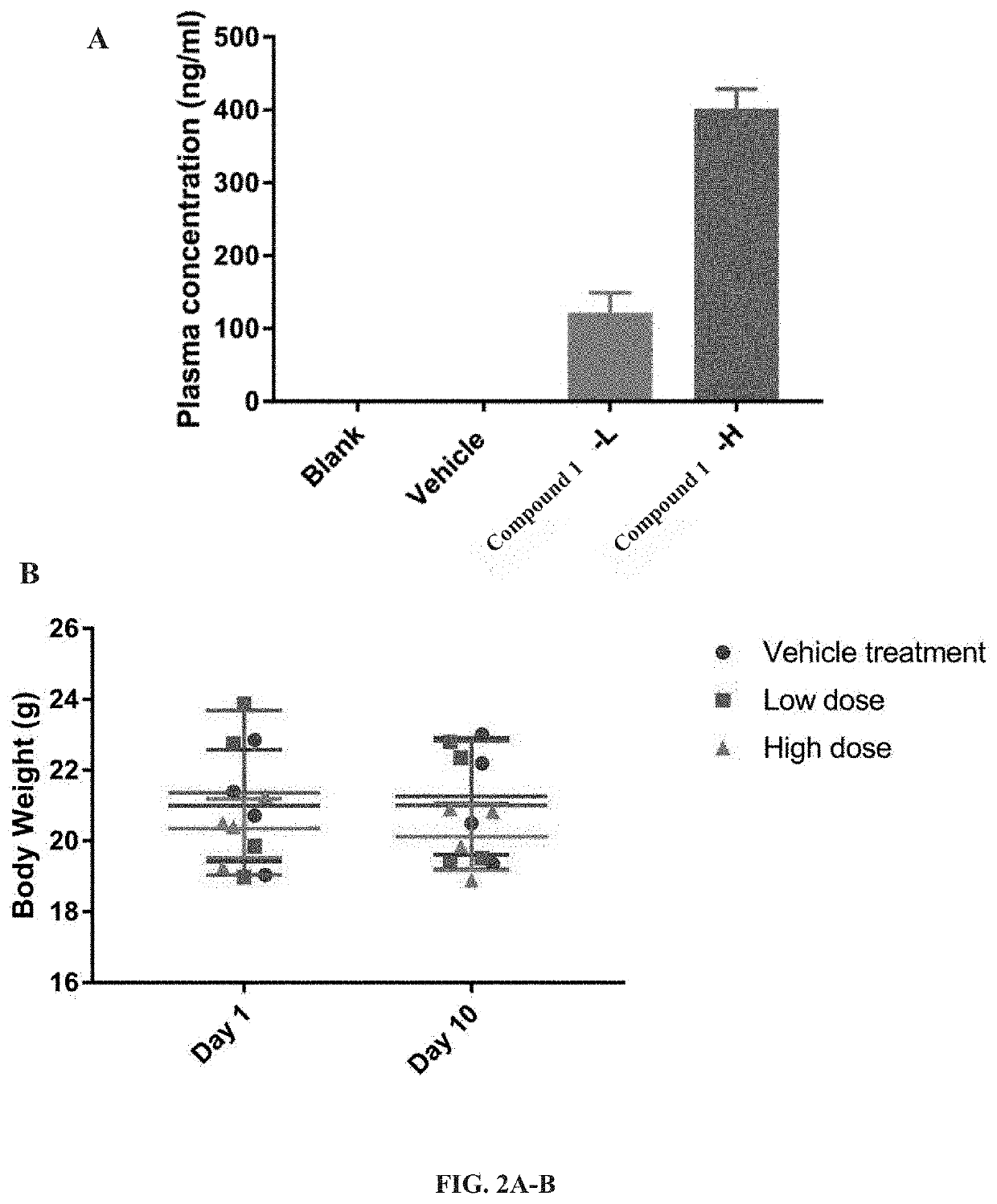Methods of treating solid tumors with CCR2 antagonists
a technology of csf1r and solid tumors, applied in the direction of antineoplastic agents, medical preparations, drug compositions, etc., can solve the problems of limited clinical response of clinical trials, inconsistent application strategies of csf1r blockade, scarcity of clinical trials with beneficial outcomes, etc., and achieve the effect of reducing the number of macrophages
- Summary
- Abstract
- Description
- Claims
- Application Information
AI Technical Summary
Benefits of technology
Problems solved by technology
Method used
Image
Examples
example 1
olecule CCR2 Antagonist Depletes Tumor Macrophages and Stimulates CD8 T Cell Accumulation in a Murine Model of Cutaneous T Cell Lymphoma (CTCL) Summary
[0216]Tumor-associated macrophages (TAMs) recruited from blood monocytes have been implicated to play a critical role in establishing an immunosuppressive tumor microenvironment (TME) that supports tumor growth. We have reported the establishment of high grade skin T cell lymphoma in syngeneic mouse skin by injection of MBL2 T lymphoma cells in ear skin followed by application of DNFB. In this model, macrophages play a key role in sustaining tumor growth. Thus, we hypothesize that blocking monocyte trafficking (through inhibition of specific chemokine receptors) into skin can influence tumor development. Herein, we examine the effects of oral administration of a small molecule drug, Compound 1, that blocks CCR2-mediated chemotaxis of monocytes in this tumor model. Following Compound 1 administration for two days after tumor initiation...
example 2
1, a CCR2 Antagonist, Inhibited Tumor Progression in a Mouse Model of Skin T Cell Lymphoma
[0217]We have previously reported an inflammation-dependent mouse T cell lymphoma model that was generated by implantation of MBL2 cells in subcutaneous skin followed by a single topical application of 2, 4-Dinitro-1-fluorobenzene (DNFB) in the ears. Implantation of MBL2 cells alone in the subcutaneous ears, though in syngeneic mice, does not result in tumor formation, presumably because the inflammation triggered by DNFB is often required for efficient tumor formation. However, when mice are applied a single dose of DNFB, a well-studied contact allergen, on the dorsal skin immediately following tumor cell implantation, the resultant tumor microenvironments (TME) allows reproducible tumor generation in two weeks. The application of DNFB induces large amount of inflammatory cells infiltrating in the TME, which contains mainly myeloid cell populations, i.e. macrophages and neutrophils. By inducin...
example 4
1 Treatment Enhances Intratumoral Inflammation
[0221]During tumor formation, the mice treated with Compound 1 showed significantly enhanced skin inflammation in the ears, which were redder and scalier than the control mice. Histological examination of tissues from day 7 revealed that ear surfaces on the dorsal side, i.e. DNFB-exposed side, exhibited surface ulceration, scaling, and obvious accumulation of inflammatory infiltrates microscopically (FIG. 4A). IHC staining with anti-F4 / 80 confirmed that macrophages were largely absent in the TME (FIG. 4B). Flow cytometry analysis on the tissues from the same time point showed a significant increase of neutrophil-like cells, which is consistent with histological manifestation (FIG. 4C). Of note, not only did the percentage increase, but also the total numbers increased, indicating that neutrophil-like cells were recruited to the TME accompanying the macrophage depletion. Thus, treatment with Compound 1 results in tumor cell necrosis and a...
PUM
| Property | Measurement | Unit |
|---|---|---|
| v/v | aaaaa | aaaaa |
| concentration | aaaaa | aaaaa |
| concentration | aaaaa | aaaaa |
Abstract
Description
Claims
Application Information
 Login to View More
Login to View More - R&D
- Intellectual Property
- Life Sciences
- Materials
- Tech Scout
- Unparalleled Data Quality
- Higher Quality Content
- 60% Fewer Hallucinations
Browse by: Latest US Patents, China's latest patents, Technical Efficacy Thesaurus, Application Domain, Technology Topic, Popular Technical Reports.
© 2025 PatSnap. All rights reserved.Legal|Privacy policy|Modern Slavery Act Transparency Statement|Sitemap|About US| Contact US: help@patsnap.com



